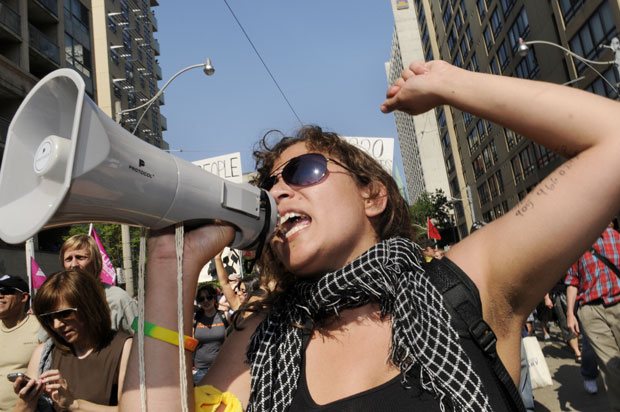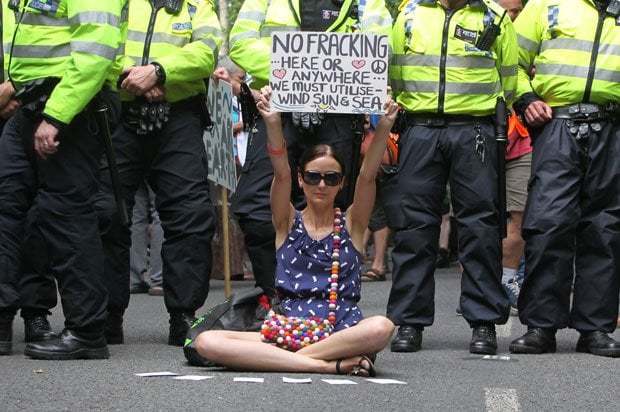How to protest safely
If you're thinking of taking to the streets in protest against...well...everything going on at the moment, make sure you know your rights and how to stay safe.

Write the number for legal support on your arm.
You might think protesting is just for people who like to wear black hoodies and ‘anonymous’ masks- but actually people from many walks of life and political persuasions get involved in protests. Why? Because taking to the streets is one way that ordinary people can make governments and corporations listen when they’re having a ‘la la la’ moment.
Protesting has won many victories, but it can also be tiring, scary and frustrating. So if you’re planning on taking part in a protest – or starting your own – here’s what you need to know.
You have a right to protest
Oh yes you do. And that right is protected by the Human Rights Act. In 2000, the UK adopted the European Convention on Human Rights. Article 11 (the right to freedom of assembly) and article 10 (the right to freedom of expression and thought) are your friends. Public bodies are forbidden to act in any way which conflict with these principles.
What if I get kettled?
‘Kettling’ is a technique used by police to quell protests by surrounding a group or groups of people and keeping them physically stuck in one place, sometimes for hours on end. It can be scary when it happens – one minute you’re doing your thing, the next minute you’re trapped and there’s no way you’ll be getting out for a while.
It’s inconvenient, yes. But it’s unlikely anything bad will happen when you’re in a kettle (unless you need to pee, in which case your drinking bottle is going to come in handy). Try to stay calm and keep your spirits up – make eye contact with the person next to you, maybe start a sing-song. Anything to stop boredom/panic.
Police use tactics like kettling to put people off protesting – but remember, you have a right to be there.
Don’t go it alone
Protesting can be tiring and scary. Make sure you take a mate – someone you trust, who’ll look after you. Bring water, warm clothes if it’s cold and snacks – getting kettled for hours can be a hungry business.
Learn more about joining an activist group.
Use cameras wisely
Sometimes it can seem like there are more cameras than protesters, but remember some people might not want to end up on Facebook or YouTube. Ask before you snap a fellow protestor. The police can stop you taking a picture if they have reason to suspect you might be involved in terrorism.
Use social media – but carefully
Use Twitter to keep in touch and find out what’s happening in real time. Protesters usually decide on a hashtag to keep each other updated. Watch out for rumours though – not every tweet is true.
Be aware that the authorities have pretty much learned how to use social media too, and that they might use it to bluff or play games. They can also listen in and track you on your mobile phone and get Internet Service Providers (ISPs) to hand over your data. This usually only happens if you’re considered to be an organiser or heavily involved in a particular protest movement. If you’re just along for the ride you’ll probably be left alone, but you should still be careful about what you post on social media.
What happens if the police stop me?
Even if you’re protesting peacefully, if you’re in a public place, the police can stop you and ask what you’re doing there (called a ‘stop and account’). You are not required to give your name or address, but the officer responsible (who must provide a receipt recording the encounter) will probably be unhappy if you don’t co-operate. If they suspect you’re carrying a weapon or engaging in terrorist activity, the police can search you, called a ‘stop and search’. They’re legally allowed to use force if you refuse to be searched.
Stop and account and stop and search are sometimes used by police at demonstrations, especially when letting people out of a kettle. The police also use Forward Intelligence Teams (FIT) to photograph protesters – something people have protested about.
What if things get violent?
Within any protest, there may be people who hold the belief that damage to property is a valid, indeed indispensable, part of making change happen. There is also a risk of violence from the police.
If you don’t want to be involved in violence, you can try to:
– hang back – when you feel people who want a piece of the action pushing forward, don’t follow them.
– avoid side streets and stay out in the open – this will help you avoid getting pinned into any police baton charges or other violence.
– watch out for sudden arrivals of huge amounts of police, especially on horseback – this signals it’s time to try and exit the area if you don’t want to engage further.
What if I get arrested?
No one leaves the house hoping to end the day at a police station, but arrest is possible at any demonstration, especially if the atmosphere is tense. If something happens to you or a friend, track down a legal observer – volunteers who try to ensure arrested protesters are treated correctly – and try to take the badge number of the officers involved in the arrest.
Write the legal support number on your arm
Most big protests will have a legal support number to call if you’re arrested. It’s sensible to write this number on your arm (so you have it even if your bag and phone are confiscated). Legal support will help arrange a solicitor for you and advise you about the legal process.
For more ideas on how to make a difference, see our article on how to become a change maker.
Next Steps
- Chat about this subject on our Discussion Boards.
By Emma Rubach
Updated on 29-Sep-2015
No featured article













